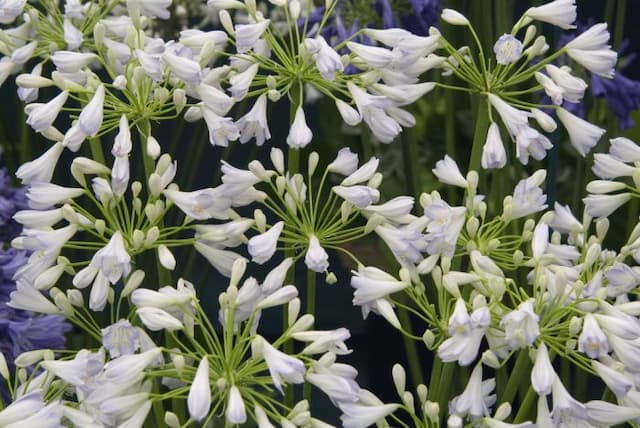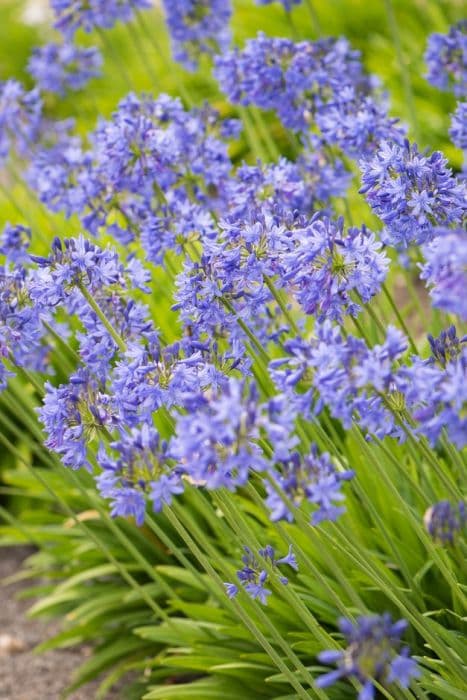Lily of the Nile Agapanthus 'Blue Imp'

ABOUT
The Agapanthus 'Blue Imp', commonly known as the African Lily or Lily of the Nile, is a captivating plant with a stunning visual appeal. It is recognized for its beautiful spherical clusters of flowers, known as inflorescences, which sit atop slender and graceful stalks. These flowers are a vivid shade of blue, hence the name 'Blue Imp', and consist of trumpet-shaped blooms that are neatly arranged to form an almost spherical bouquet. Their petals can sometimes have a gradient of color, ranging from a deep, intense blue at the base, softly blending into a lighter, more soothing shade at the tips. The cluster of blooms creates a magnificent display, which becomes a focal point wherever the plant is situated. Each individual flower consists of six petals and they attract not only human admires but also a variety of pollinators, including bees and butterflies. The foliage of the African Lily 'Blue Imp' is equally impressive. The plant boasts strappy, lush green leaves which form a dense and arching foliage clump. These leaves can be quite long and are typically glossy with a leathery texture, providing a rich green backdrop that further accentuates the dazzling blue of the blooms above. The contrast between the green foliage and blue flowers is a sight to behold and is often desired by gardeners looking to add a splash of color to their landscape. Overall, the Agapanthus 'Blue Imp' is loved for its striking flower display and elegant foliage, making it a stunning choice for borders, pots, or as a feature plant in a garden setting. It brings a touch of exotic charm with its bright blue flowers and adds a cool color palette to the greens commonly found in gardens.
About this plant
 Names
NamesFamily
Amaryllidaceae
Synonyms
African Lily, Lily of the Nile, Love Flower
Common names
Agapanthus 'Blue Imp'
 Toxicity
ToxicityTo humans
Lily of the Nile, also known as Agapanthus 'Blue Imp', can be harmful if ingested. All parts of the plant contain toxic substances that can cause symptoms such as nausea, vomiting, and diarrhea if consumed by humans. In severe cases, ingesting this plant may lead to dizziness and difficulty swallowing.
To pets
Lily of the Nile is also toxic to pets. Ingestion of any part of the plant can cause symptoms such as vomiting, diarrhea, anorexia, and drooling in animals. Severe poisoning can result in tremors, heart problems, and respiratory issues. It's crucial to keep pets away from the plant to prevent accidental ingestion.
 Characteristics
CharacteristicsLife cycle
Perennials
Foliage type
Evergreen
Color of leaves
Green
Flower color
Blue
Height
2 feet [60 cm]
Spread
2 feet [60 cm]
Plant type
Bulb
Hardiness zones
8
Native area
South Africa
Benefits
 General Benefits
General Benefits- Ornamental Value: Agapanthus 'Blue Imp', commonly known as African Lily, has striking blue flowers that are visually appealing and add a splash of color to gardens.
- Drought Tolerance: African Lily is relatively drought resistant, making it a good choice for water-efficient landscaping.
- Low Maintenance: It requires minimal care once established, making it suitable for gardeners who prefer low-maintenance plants.
- Pest and Disease Resistance: It is generally resistant to pests and diseases, reducing the need for chemical interventions.
- Attracts Pollinators: The flowers attract bees, butterflies, and other pollinators that are beneficial to the ecosystem.
- Long Blooming Period: African Lily has a long flowering season, providing color and interest in the garden for an extended period.
- Container Gardening: It can be grown in pots or containers, making it versatile for patios, balconies, and areas with limited space.
- Soil Adaptability: This plant can adapt to a range of soil types, although it prefers well-drained soils.
- Erosion Control: African Lily can help in stabilizing slopes and preventing soil erosion due to its clumping growth habit.
- Cut Flowers: The blooms make excellent cut flowers for arrangements, lasting well in vases.
 Medical Properties
Medical PropertiesThis plant is not used for medical purposes.
 Air-purifying Qualities
Air-purifying QualitiesThis plant is not specifically known for air purifying qualities.
 Other Uses
Other Uses- Flower Arranging: Agapanthus flowers are popular in floral arrangements due to their long-lasting blooms and vibrant blue color, providing a striking presence in bouquets and centerpieces.
- Garden Borders: Agapanthus 'Blue Imp' is often used to create dramatic borders in gardens, as their clumping nature and attractive foliage make them ideal for edging pathways and garden beds.
- Pollinator Attraction: The flowers of the Agapanthus 'Blue Imp' are known to attract bees, butterflies, and other beneficial pollinators, thereby supporting local ecosystems.
- Photography Backdrop: The striking appearance of Agapanthus 'Blue Imp' makes it an excellent backdrop for garden photography, enhancing the aesthetic appeal of garden images.
- Privacy Screening: When planted in groups, Agapanthus 'Blue Imp' can provide a semi-dense screen, offering a degree of privacy in garden spaces or patios.
- Container Gardening: Due to its compact size, Agapanthus 'Blue Imp' is well-suited for container gardening and can add a splash of color to balconies, decks, or patios.
- Themes Gardens: Agapanthus 'Blue Imp' is often included in "blue" theme gardens where different shades of blue flowers are showcased together for a visually harmonious display.
- Culinary Garnish: Although not commonly used for culinary purposes, the blooms of Agapanthus can be used as an ornamental garnish for special dishes, assuming they have not been treated with pesticides.
- Pond Borders: Agapanthus 'Blue Imp' can be used around the borders of ponds or water features in the garden, contributing to a lush waterside aesthetic.
- Craft Projects: Dried Agapanthus flowers can be incorporated into craft projects, such as handmade wreaths or as part of dried flower arrangements for long-lasting decor.
Interesting Facts
 Feng Shui
Feng ShuiThe Lily of the Nile is not used in Feng Shui practice.
 Zodiac Sign Compitability
Zodiac Sign CompitabilityThe Lily of the Nile is not used in astrology practice.
 Plant Symbolism
Plant Symbolism- Love Letters: The name Agapanthus is derived from the Greek words 'agape' meaning love, and 'anthos' meaning flower. The 'Blue Imp' variety, with its striking blue hues, is often seen as a symbol of love letters or messages from the heart.
- Enduring Love: As a perennial plant that returns each year with vibrant blooms, Agapanthus symbolizes enduring or long-lasting love.
- Beauty: The striking appearance of the 'Blue Imp', with its lovely blue flowers, makes it a symbol of beauty and admiration.
- Fertility: In some cultures, the abundance of flowers produced by the Agapanthus can symbolize fertility and creation.
- Protection: Because of its use in traditional medicine and its strong presence in gardens, Agapanthus is thought to offer protective qualities.
 Water
WaterThe African Lily should be watered deeply to saturate the root zone, then allowed to dry out somewhat between waterings, typically this means watering every few days during the active growing season, especially in hotter climates. During the winter or when the plant is dormant, reduce watering to every couple of weeks, depending on your climate and the humidity levels. It is important not to overwater as this can lead to root rot. An average amount could be around 1 gallon every week during the peak summer months for an outdoor plant, adjusting as necessary for rainfall and temperature conditions.
 Light
LightAfrican Lily thrives best in full sun to partial shade. It should be placed in a spot where it can receive at least six hours of sunlight each day for optimal growth and flower development. However, in extremely hot climates, it benefits from some shade during the harshest afternoon sun to prevent scalding.
 Temperature
TemperatureAfrican Lily can tolerate a range of temperatures but grows best when daytime temperatures are between 70-80°F and nighttime temperatures are above 50°F. It should not be exposed to temperatures below 28°F, as it can severely damage the plant. The ideal growing conditions mimic its native warm and temperate environments.
 Pruning
PruningPruning African Lily involves cutting back spent flower stems to the base after blooming to encourage a tidy appearance and possibly a second flush of flowers. In early spring, remove any damaged or dead leaves. Pruning is typically done annually, primarily post-flowering, which is generally late summer or early fall.
 Cleaning
CleaningAs needed
 Soil
SoilAfrican Lily 'Blue Imp' thrives in well-draining soil mixed with compost and a bit of sand to improve drainage. The ideal soil pH for the African Lily is between 6.0 and 8.0, leaning towards a neutral to slightly alkaline range.
 Repotting
RepottingAfrican Lily 'Blue Imp' should be repotted every 2 to 3 years, or when the root system becomes crowded within the pot. This ensures continued growth and bloom.
 Humidity & Misting
Humidity & MistingAfrican Lily 'Blue Imp' prefers moderate humidity levels, typical of outdoor environments, but can tolerate drier indoor conditions as long as it's not too arid.
 Suitable locations
Suitable locationsIndoor
Place African Lily 'Blue Imp' near a sunny window and water moderately.
Outdoor
Plant African Lily 'Blue Imp' in sunny spots; water and mulch well.
Hardiness zone
8-11 USDA
 Life cycle
Life cycleAgapanthus 'Blue Imp', commonly known as Lily of the Nile, begins its life as a seed, which germinates in moist, well-drained soil in a sunny location. Once the seedling emerges, it develops a set of true leaves and continues to grow into a juvenile plant, forming a clump of strap-like foliage. As the plant matures, it forms a strong underground rhizome that will become the foundation for future growth. In the flowering stage, typically during summer, Lily of the Nile produces tall stalks topped with clusters of trumpet-shaped blue or violet flowers. After the flowering, seeds form and can be harvested for propagation or will naturally drop to the ground to potentially germinate new plants. The plant then goes into a period of dormancy in colder climates or may continue to grow in milder regions, with the cycle repeating the following season.
 Propogation
PropogationPropogation time
Spring-Early Summer
The most popular method for propagating the Agapanthus 'Blue Imp', commonly known as Lily of the Nile, is through division of its clumps. This process is ideally carried out in the spring, just before the growing season starts, when plants are beginning to come out of dormancy. To propagate, carefully lift the entire Agapanthus clump out of the ground using a shovel. Gently separate the clump into smaller sections, making sure each section has at least one or two healthy growth points or shoots. Replant the divisions promptly into well-prepared soil with good drainage, spacing them about 12 to 18 inches (30 to 45 cm) apart to give them enough space to grow. Water the new plants thoroughly after planting to help establish them. Divisions will typically take root and start to show new growth within a few weeks, provided they are kept well-watered and free from competing weeds.









